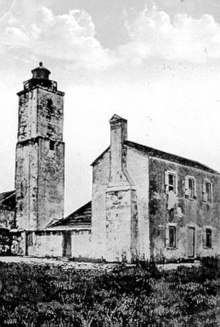History[edit]
Juan Ponce de León may have landed on the barrier island in 1513.[6] Spanish Admiral Pedro Menéndez de Avilés, founder of St. Augustine, moved his initial settlement to Anastasia Island after a revolt by the Timucuan Indians in 1566.[7] This settlement was short-lived, and the colonists moved back to the mainland[8] at the site of present-day downtown St. Augustine.
The Spanish built a wooden watch-tower on the northern end of Anastasia Island [9] to warn the town of approaching vessels by raising signal flags.[10] It was sighted by Sir Francis Drake in 1586;[11][12] consequently he came ashore and attacked the city.[13] The Spanish eventually replaced the tower with a coquina structure that was converted into a lighthouse soon after Florida came into the possession of the United States[14] in 1821.[15][16] This was replaced by the present-day St. Augustine Light in 1874.[17] The original lighthouse collapsed in 1880 due to beach erosion and the encroachment of the sea. The earliest built residence on Anastasia Island still standing is the lighthouse keepers' house built in 1876[17] next to the present lighthouse. Several other houses in the Lighthouse Park neighborhood date to the 1880s.
The island was part of a 10,000 acre land grant from the Spanish crown to the land dealer Jesse Fish.[18] The tract was then purchased at auction in 1792 by his son, Jesse Fish, Jr.[19] It amounted to the whole of "St. Anastasia" island except certain lands marked off by officials as reserved, such as the King's Quarry.[20] The claim of Sarah Fish, Jesse Fish, Jr.'s wife and heir, was reported to Congress in 1826 as valid by the commissioners for East Florida and the Secretary of State of the US, and subsequently confirmed by an act of Congress on May 23, 1828.[21] Jesse Fish, Sr. had established a plantation, El Vergel (The Orchard), in 1763[22] and built his home on the island; there he planted an orange grove which produced fruit celebrated as far away as London[23] for its juiciness and sweetness.[24] His production increased annually until 1776, when he shipped a total of 65,000 oranges from Florida.
The land developer David Paul Davis, known as "D. P." or "Doc", a native of Green Cove Springs,[25] developed the Davis Shores neighborhood at the north end of Anastasia Island during the land boom of the mid–1920s. In 1925–1926 he filled in the extensive salt marshes located directly opposite the center of St. Augustine across the Matanzas River.[26] As the construction bubble collapsed and real estate values plummeted, D.P. Davis mysteriously disappeared at sea on October 12, 1926.[27] Construction of theBridge of Lions had begun in 1925 to provide access to his projected development and was completed in 1927.[28] During World War II the Coast Guard occupied the lighthouse, and other residences in Davis Shores were used as barracks for soldiers.
Beneath the sandy soil of most of the island lie layers of coquina, a shelly rock in various stages of consolidation. This rock is composed primarily of whole and fragmented shells of the donax, or coquina, clam[7] admixed occasionally with scattered fossils of various marine vertebrates, including sharks' and rays' teeth. This deposition is known as the Anastasia Formation,[2] and was formed during the Late Pleistocene epoch, in the period of successive glacial ages from about 110,000 years to 11,700 years ago. It is the only local natural source of stone, and was quarried by the Spanish and later the British to construct many of the buildings in St. Augustine (including the Castillo de San Marcos). An old well and chimney made of coquina rock, located on Old Beach Road,[29] are all that remain of the Spanish barracks built to house the workers who mined the coquina for construction of the fort.[16] These included quarry overseers, masons, and stonecutters.[30] The years-long project (1672-1695) was accomplished with the help of Native American forced labor and African slaves.[31]

No comments:
Post a Comment